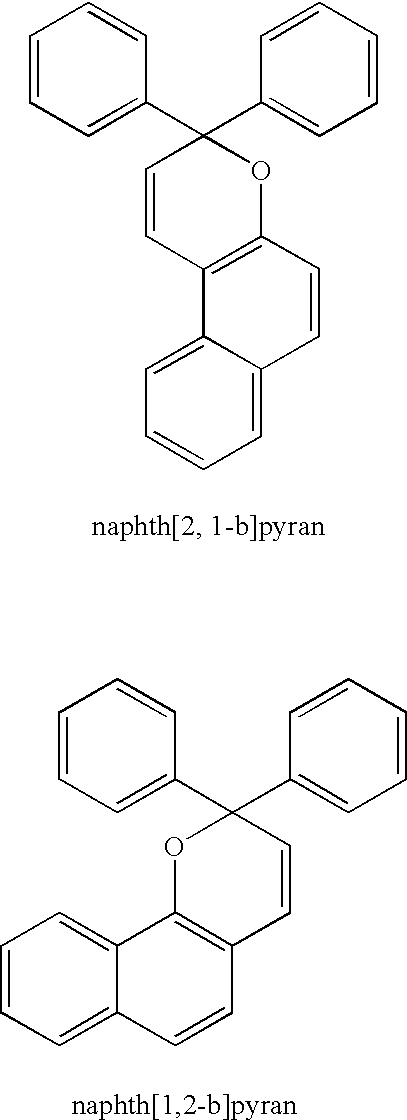Photochromic polyurethane laminate
a polyurethane and photochromic technology, applied in the field of photochromic laminates, can solve the problems of affecting the smooth surface quality, the inability to meet the requirements of photochromic dye application, and the relatively thick coating on the surface, etc., to achieve the effect of enhancing the fatigue resistance of photochromic compounds, enhancing the dimensional stability of the polyurethane layer, and enhancing the curability
- Summary
- Abstract
- Description
- Claims
- Application Information
AI Technical Summary
Benefits of technology
Problems solved by technology
Method used
Image
Examples
example 1
[0071] Preparation of Isocyanate Polyurethane Prepolymer A: In a 3-necked flask equipped with an overhead stirrer, thermocouple, and a vacuum adapter, 393.5 g (3 equivalents) of 4,4′-dicyclohexylmethanediisocyanate (H12MDI, available from Bayer as Desmodur W) was charged into the reactor and stirred at ambient temperature. 1000 g (2 equivalents) of a polycaprolactone diol having an OH number of 112 mg KOH / g and a number average molecular weight of about 1000 g / mole (available from Dow Chemical as Tone™ 2221) was preheated in an oven to 80° C. and added to the reactor. The mixture was allowed to stir for about 15 minutes, before adding 6 g of dibutyltin dilaurate catalyst (available from Air Products as T-12). The reaction flask was evacuated (<0.1 mm HG) and held at 90° C. for 6 hours. An aliquot of the prepolymer was withdrawn and titrated for isocyanate content using standard n-butyl amine titration. The isocyanate content was found to be 2.92% (theory; 3.0%).
example 2
[0072] Preparation of Isocyanate Polyurethane Prepolymer B: In a 3-necked flask equipped with an overhead stirrer, thermocouple, and a vacuum adapter, 613.0 g (4.67 equivalents) of 4,4′-dicyclohexylmethanediisocyanate (H12MDI, available from Bayer as Desmodur W) was charged into the reactor and stirred at ambient temperature. 1000 g (2 equivalents) of a polycaprolactone diol having an OH number of 112 mg KOH / g and a number average molecular weight of about 1000 g / mole (available from Dow Chemical as Tone™ 2221) was preheated in an oven to 80° C. and added to the reactor. The mixture was allowed to stir for about 15 minutes, before adding 8 g of dibutyltin dilaurate catalyst (available from Air Products as T-12). The reaction flask was evacuated (<0.1 mm HG) and held at 90° C. for 6 hours. An aliquot of the prepolymer was withdrawn and titrated for isocyanate content using standard n-butyl amine titration. The isocyanate content was found to be 6.75% (theory; 7.0%).
[0073] Preparatio...
example 4
[0074] A solution was first made by dissolving 4 g of the thermoplastic polyurethane preapared in Example 3 in 16 g of anhydrous tetrahydrofuran. To the solution was further added 4 g of the isocyanate prepolymer prepared in Example 1, 0.14 g of CR49 dye, 0.02 g CR59 dye, 0.17 g each of Irganox-1010, Tinuvin-144, and Tinuvin-765. The mixture was stirred at room temperature for 3 hours before cast on an easy release liner (available from CPFilms as T-50) with draw bar targeting a 38 micrometer dry film thickness. The solvent in the cast film was evaporated at 60° C. for 5 minutes with airflow above the film. The dried film was transfer-laminated between two 0.3 mm thick polycarbonate sheets (available from Teijin as PC-1151) with a bench top roller laminator. After 4 days under ambient, the laminate was cured at 70° C. for 3 days.
[0075] The laminate was cut into a 76 mm disc and used to make a segmented multi-focal polycarbonate photochromic lens. After the insert injection molding ...
PUM
| Property | Measurement | Unit |
|---|---|---|
| thickness | aaaaa | aaaaa |
| thickness | aaaaa | aaaaa |
| thickness | aaaaa | aaaaa |
Abstract
Description
Claims
Application Information
 Login to View More
Login to View More - R&D
- Intellectual Property
- Life Sciences
- Materials
- Tech Scout
- Unparalleled Data Quality
- Higher Quality Content
- 60% Fewer Hallucinations
Browse by: Latest US Patents, China's latest patents, Technical Efficacy Thesaurus, Application Domain, Technology Topic, Popular Technical Reports.
© 2025 PatSnap. All rights reserved.Legal|Privacy policy|Modern Slavery Act Transparency Statement|Sitemap|About US| Contact US: help@patsnap.com

